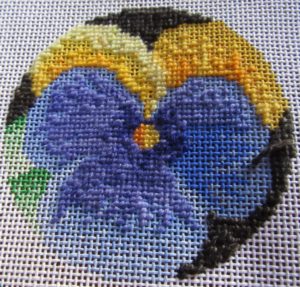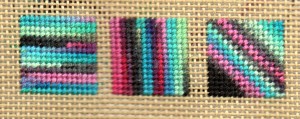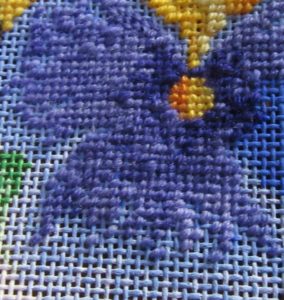
Today I wanted to talk about three things you’ll see on the pansy for our pixel shading project. I’ve completed the lightest and darkest yellow, the darkest violet, the center, and most of the medium violet. The next post, in two weeks, will finish the project.
Stitching with Hand-dyed Threads

Although it may not look obvious to you in the skein almost all hand-dyed threads have some variation in color. It can be very subtle, like the variation in the left petal of the medium violet. It can only be a small patch, like the dark violet in the middle petal. It can be pretty extensive, as the dark yellow on the right petal.
It’s subtle that is until you stitch in Basketweave. Stitches made in diagonal rows amplify the color changes. Basketweave is the worst offender. Because you are stitching in diagonal rows, the stitches in one row sit between the stitches of the adjacent rows. When there is a color difference between the rows, the result is a dotted line of one of the colors. The greater the variation, the worse this looks. Even if the variation is subtle, this method of making Tent will draw attention to the changes.
That’s why I always recommend stitching with hand-dyed threads in Continental. Because this stitch is made in straight lines, the color changes don’t draw attention to themselves. It’s easy to see what I mean in these three samples in a very loud overdye above.

Because Continental can be stitched in vertical or horizontal rows, you will want to pick stitch directions that match what you are stitching. I could see from the dark violet and the painting on the canvas that the movement of color was from the center to the outside of the petals. That means the side petals are stitched with horizontal rows, the picture of the left petal above shows this clearly. The bottom petal should be stitched in vertical rows. This stitching is not as clear-cut as it should be because I decided this partway through. Because the rows are short I got clumps of color instead of lines, which is another way to handle overdyes (learn about it here).
Filling in Skipped Stitches

One aspect of pixel shading that makes it work is the scattering of stitches in the adjacent color. When you have not stitched that color yet, this is easy to do. You can clearly see the uneven edges and scattered stitches of the medium violet in the areas stitched.
But filling in those skipped spaces can be tough. You can see on the right petal where I filled in medium violet inside the dark violet.
This process is best left for a time when you have strong light and possibly even a magnifier. It can be hard to get these stitches correctly placed and with good tension. I always leave stitching these areas until daytime in bright light (these were stitched outside). I also sometimes find that thinning my thread helps when the scattered stitches look too big.
Once you have completed your project, use a magnifying glass to go over it, looking for skipped stitches; these scattered stitches are easy to miss.
Stitching the Middle Last

If you are feeling uncomfortable about the edges when you re pixel shading, a great technique is to stitch the areas on each side of a color. I did this on the left yellow petal. Because you are not filling in adjacent areas, it’s easy to make uneven edges. While the uneven edges of the dark yellow were obvious, stitching the light yellow means the filling in the medium yellow will go very easily. On the right petal everything is that color. On the left petal I only have to fill in the missing stitches.
I like to use this method when I am someplace where it’s easy to stitch so I can do the fill-in stitches where it isn’t quite as easy. This makes for some stressless needlepoint that is a welcome break from the concentration I’ll need to finish the middle violet petal. It’s the only one with all four shades of violet.
The last post on this project will be on August 26.
About Janet M Perry
Janet Perry is the Internet's leading authority on needlepoint. She designs, teaches and writes, getting raves from her fans for her innovative techniques, extensive knowledge and generous teaching style. A leading writer of stitch guides, she blogs here and lives on an island in the northeast corner of the SF Bay with her family

Leave a Reply